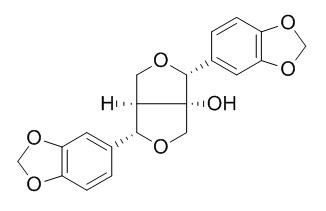Paulownin
Paulownin has the action of anti-inflammation,analgesia,immunity,hypoglycemia and has little toxicity. Paulownin demonstrates inhibitory activities against H. pylori Cystathionine gamma- synthase (HpCGS) with IC50 values of 19 +/- 2 microM, it can highly inhibit the growth of H. pylori and exhibit strong inhibitory specificity against H. pylori related to E. coli. (+)-Paulownin is active against the MCF-7 breast cancer cell line with IC50 values of 14.0 uM.
Inquire / Order:
manager@chemfaces.com
Technical Inquiries:
service@chemfaces.com
Tel:
+86-27-84237783
Fax:
+86-27-84254680
Address:
1 Building, No. 83, CheCheng Rd., Wuhan Economic and Technological Development Zone, Wuhan, Hubei 430056, PRC
Providing storage is as stated on the product vial and the vial is kept tightly sealed, the product can be stored for up to
24 months(2-8C).
Wherever possible, you should prepare and use solutions on the same day. However, if you need to make up stock solutions in advance, we recommend that you store the solution as aliquots in tightly sealed vials at -20C. Generally, these will be useable for up to two weeks. Before use, and prior to opening the vial we recommend that you allow your product to equilibrate to room temperature for at least 1 hour.
Need more advice on solubility, usage and handling? Please email to: service@chemfaces.com
The packaging of the product may have turned upside down during transportation, resulting in the natural compounds adhering to the neck or cap of the vial. take the vial out of its packaging and gently shake to let the compounds fall to the bottom of the vial. for liquid products, centrifuge at 200-500 RPM to gather the liquid at the bottom of the vial. try to avoid loss or contamination during handling.
Adaptive Medicine 2020, 12(1): 4-10
ACS Omega2020, 5,33,20825-20830
Dermatologica Sinica2024, 42(1):p19-30.
Int J Mol Sci.2019, 20(21):E5488
Int J Mol Sci.2021, 22(9):5012.
Nutrients.2024, 16(16):2612.
J Agric Food Chem.2021, 69(14):4210-4222.
Biomolecules.2021, 11(10):1537.
Food Chem.2024, 460(Pt 1):140472.
Korean J. of Horticultural Sci. & Tech. 2017, 793-804
Related and Featured Products
Nat Prod Commun. 2012 Oct;7(10):1333-6.
Two new naphthoquinone derivatives from the stem bark of Callicarpa maingayi.[Pubmed:
23157003]
METHODS AND RESULTS:
Two new naphthoquinones designated as 3alpha-hydroxy-2-(2-hydroxypropan-2-yI)-9alpha-methoxy-2,3,3alpha,9alpha-tetra-hydronaphtho[2,3-b]furan-4,9-dione (callicarpa-quinone A, 1) and 5-hydroxy-2-(2-hydroxypropan-2-yl)naphtho[2,3-b]furan-4,9-dione (callicarpaquinone B, 2) were isolated from the chloroform fraction of Callicarpa maingayi. Three other known compounds, identified as avicequinone-C (3), wodeshiol (4) and Paulownin (5), were reported for the first time from this species. The structure elucidation of compounds was established by comprehensive 1D and 2D NMR spectroscopic analyses as well as EIMS, UV and IR spectral data. Compounds 1 and 2 were tested in vitro for their cytotoxic activity against human breast cancer MCF-7cells.
CONCLUSIONS:
Compound 2 exhibited strong cytotoxic activity with an IC50 value of 1.9 +/- 0.2 microM, while 1 showed moderate activity with an IC50 value of 25.0 +/- 4.3 microM.
J Biochem. 2008 Jan;143(1):59-68.
Enzymatic characterization and inhibitor discovery of a new cystathionine {gamma}-synthase from Helicobacter pylori.[Pubmed:
17981822]
Cystathionine gamma-synthase (CGS) catalyses the first step of the transsulfuration pathway that converts l-cysteine to l-homocysteine in bacteria, whereas this pathway is absent in human.
METHODS AND RESULTS:
In this report, we identified a new metB gene from Helicobacter pylori strain SS1, and the recombinant H. pylori Cystathionine gamma-synthase (HpCGS) was successfully cloned, expressed and purified in Escherichia coli system. Enzymatic study of HpCGS indicated that the K(m) and k(cat)/K(m) values against the substrate O-succinyl-l-homoserine (l-OSHS) were 3.02 mM and 98.7 M(-)(1)s(-)(1), respectively. Moreover, four natural products (alpha-lapachone, 9-hydroxy-alpha-lapachone, Paulownin and Yangambin, Fig. 1) were discovered to demonstrate inhibitory activities against HpCGS with IC(50) values of 11 +/- 3, 9 +/- 1, 19 +/- 2 and 27 +/- 6 microM, respectively.
CONCLUSIONS:
All these four inhibitors prevent the binding of l-OSHS to HpCGS in a non-competitive fashion.
In vitro antibacterial assays further indicated that these four discovered compounds could highly inhibit the growth of H. pylori and exhibited strong inhibitory specificity against H. pylori related to E. coli.
Guangxi Sciences, 2007, 14(4):405-6.
The Experiment Studies on Pharmcological Action of Paulownin[Reference:
WebLink]
To observe the anti-inflammation,analgesia,immunite,hypoglycemia action of Paulownin.
METHODS AND RESULTS:
Used the methods of ear swelling cused by xylene,acetic acid twisting,carbon expurgation and the hyperglycemia induced by glucose,to observe the pharmcological action of Paulownin;and acute toxicity was observed.Paulownin in high does could inhibit significantly ear swelling induced by xylene,high and low does could decrease body twisting times induced by acetice,and Paulownin in high and low does could increase the phagocytic funtion of mononu clear phagocyte;Paulownin in high dose could obviously decrease blood glucose,and low dose had the action on hypoglycemia in hyperglycemia mice induced by glucose.
CONCLUSIONS:
The acute toxicity test of Paulownin showed that its maximum tolerance is 4.5g/kg in mice.Paulownin has the action of anti-inflammation,analgesia,immunity,hypoglycemia and has little toxicity.
Planta Med. 2011 Jun;77(9):951-4.
Lignans and other constituents from the roots of the Vietnamese medicinal plant Pseuderanthemum palatiferum.[Pubmed:
21243588]
METHODS AND RESULTS:
Two new lignans, palatiferin A (1) and palatiferin B (2), were isolated from the roots of Pseuderanthemum palatiferum, together with five known triterpenes, epifriedelanol (3), lupeol (4), lupenone (5), betulin (6), pomolic acid (7), and a dipeptide asperglaucide (8). Their structures were established from 2D NMR and mass spectroscopy. The absolute configuration of 1 and 2 was proposed based on the comparison of their optical rotation activities with those of compounds with similar structures such as wodeshiol and Paulownin.
CONCLUSIONS:
The new lignans, palatiferin A (1) and palatiferin B (2) exhibited a moderate cytotoxicity against KB and HepG2 cell lines. However, betulin and lupeol, two abundant compounds from the roots of P. palatiferum, showed cytotoxic and antimicrobial activities.



